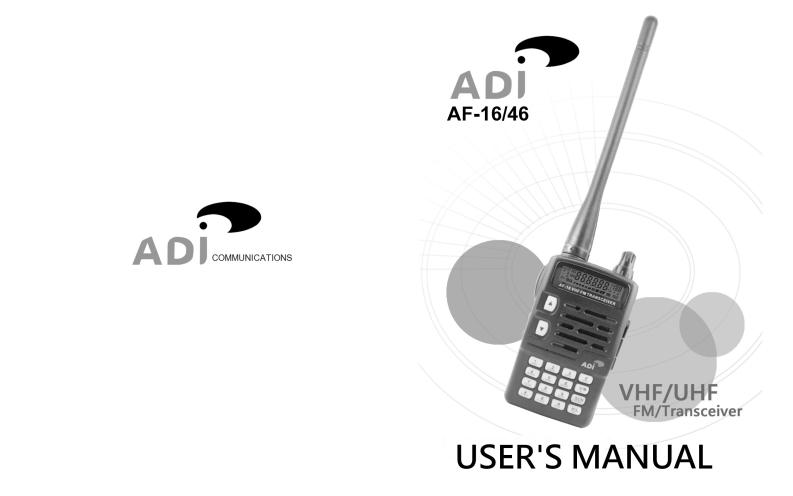ADi Communications AF-46, AF-16 User Manual

Dear users,
We are grateful you choose ADI for your land mobile radio applications. We believe this easy- to-use transceiver will provide dependable and reliable communication to personnel operation at peak efficency.
ADI transceivers incorporate the latest advanced technology. As a result, we feel strongly that you will be pleased with the quality and features of this product!
For you to understand the operation and maintenance of this transceiver, please read carefully the user’s manual.
This manual is applicable to the following models:
AF-16 VHF frequency modulation wireless transceiver. AF-46 UHF frequency modulation wireless transceiver.

CONTENT |
|
SAFETY INFORMATION........................... |
1-2 |
UNPACKING AND CHECKING EQUIPMENT............... |
3 |
SUPPLIED ACCESSORIES........................ |
3 |
PREPARATION.................................. |
4-6 |
CHARGING THE BATTERY PACK.................... |
4 |
INSTALLING/REMOVING THE ANTENNA............... |
5 |
INSTALLING/REMOVING THE LI-ION BATTERY PACK...... |
5 |
INSTALLING THE BELT CLIP..................... |
6 |
INSTALLING THE HAND STRAP.................... |
6 |
INSTALLING THE OPTIOPNAL EARPHONE............. |
6 |
GETTING ACQUAINTED.......................... |
7-12 |
ORIENTATION............................... |
7 |
KEYPAD OPERATION........................... |
9 |
LCD DISPLAY.............................. |
11 |
BASIC OPERATION............................ |
13-14 |
BASIC MODES.............................. |
13 |
VFO MODE (FREQUENCY DISPLAY MODE)......... |
13 |
MR NODE (MEMORY REACALL MODE)............ |
13 |
CH MODE (CHANNEL DISPLAY MODE)............ |
13 |
SWITCH POWER ON/OFF........................ |
13 |
ADJUST THE VOLUME......................... |
14 |
SELECT A FREQUENCY......................... |
14 |
SELECT AN OUTPUT POWER..................... |
14 |
FUNCTION SETTING AND DESCRIPTION........... |
15-24 |
ADJUST SQUELCH (SQL)....................... |
15 |
BATTERY SAVER (SAVE)....................... |
15 |
AUTOMATIC POWER OFF (APO)................... |
16 |
KEYPAD BEEPER (BEEP)....................... |
16 |
KEYPAD LOCK (LOCK)......................... |
16 |
RECEIVE WITH CTCSS/DCS..................... |
17 |
CONTENT |
|
TRANSMIT WITH CTCSS/DCS....................... |
18 |
CTCSS STANDARD FREQUENCY TABLE.................. |
19 |
DCS STANDARD SETS........................... |
19 |
SETTING OFFSET DIRECTION AND OFFSET FREQUENCY (ASY)... |
20 |
VOICE COMPANDER/SCRAMBLER (APS)................. |
21 |
MEMORY CHANNEL SCAN LOCK/UNLOCK (SA/D)............ |
21 |
FREQUENCY STEP SETTING..................... |
22 |
BROAD/NARROW BAND (W/N).................... |
22 |
TIME OUT TIMER (TOT)....................... |
22 |
SCAN (SCAN).............................. |
23 |
SCAN METHOD........................... |
23 |
SELECTING SCAN METHOD................... |
23 |
VFO SCAN................................. |
24 |
MEMORY CHANNEL SCAN........................ |
24 |
MEMORY CHANNEL............................. |
25-27 |
STORING MEMORY CHANNEL..................... |
25 |
USING MEMORY CHANNEL....................... |
25 |
INITIALIZING MEMORY........................ |
26 |
FULL RESET INITIALIZATION (MEMORY MODE).... |
26 |
PARTIAL RESET INITIALIZATION (VFO MODE).... |
26 |
CHANNEL RESET INITIALIZATION (MR MODE)..... |
27 |
USAGE AND MAINTENANCE INSTRUCTION............. |
28 |

SAFETY INFORMATION
Please read the following rules before use. Failure to comply with them may cause danger or violate laws. This manual provides with detailed safety information.
SWITCH ON SAFELY
Do not switch the device on when transceiver use is prohibited or when it may cause interfer _ence or danger.
ROAD SAFETY COMES FIRST
Obey all traffic rules. Always keep your hands free to operate the vehicle while driving. Your first consideration while driving should be road safety.
INTERFERENCE
All wireless devices may be susceptible to interference, which could affect performance.
SWITCH OFF IN HOSPITALS
Follow any restrictions. Switch the device off near medical equipment.
SWITCH OFF IN AIRCRAFT
Follow any restrictions. Wireless devices can cause interference to aircraft communication.
SWITCH OFF WHEN REFUELING
Do not use the transceiver at gas stations. Do not use fuel or chemicals.
SAFETY INFORMATION
SWITCH OFF NEAR EXPLOSIVE PLACES Follow any restrictions. Do not use the transceiver in the explosive places.
USE SENSIBLY
Use only in the normal position as explained in the product documentation. Do not touch the antenna unnecessarily.
QUALIFIED SERVICE
Only qualified personnel may disassemble or repair the transceiver.
ACCESSORIES AND BATTERIES
Use only approved accessories and batteries. Do not connect incompatible products.
WATER-RESISTANCE
Your transceiver provides with simple design for rain resisrance only. Please keep it dry as possibly as you can.
BACK-UP COPIES
Remember to make back-up copies or keep a written record of all important information.
CONNECTING TO OTHER DEVICES When connecting to other device, read the relevant user guide for detailed safety instruc
_tions. Do not connect incompatible products.

UNPACKING AND CHECKING EQUIPMENT |
PREPARATION |
Welecome to use ADI wireless transceiver, we suggest to take the following steps before use:
•Please check the packing box to see if there is any damage.
•Please carefully unpack the packing, and identify the items listed below. If any items are missing or damaged, please contact the dealer.
SUPPLIED ACCESSORIES |
|
||
|
|
ITEM |
QUANTITY |
|
|
Wireless Transceiver |
1 |
|
|
Antenna |
1 |
|
|
Lithium Battery Pack |
1 |
|
|
Desk Top Charger |
1 |
|
|
Adapter |
1 |
|
|
Belt Clip |
1 |
|
|
User’s Manual |
1 |
|
|
Warranty Card |
1 |
PREPARATION
CHARGING THE BATTERY PACK
The battery pack is not fully charged at the factory, please charge it before use. Initially charging the battery pack after purchase or extended storage (greater than 2 months) will not bring the battery pack to its normal operating capacity. After repeating the charge/discharge cycle two or three times, the operating capacity will increase to normal.
Please charge according to the following steps: 1.Plug the adapter into a 110V socket.
2.Plug the DC plug into the DC jacket located on the back of the charger.
3.The charging LED lights green when the charger is to be charged.
4.Slide the battery pack or transceiver with the battery pack into the desktop charger.
5.Make sure the battery pack contacts are in contact with the charging terminals. The charging LED lights red and charging begins.
6.Afrer charging about 3 hours, when the light turns to green, it means the battery pack is fully charged. Then you can take off the battery pack or transceiver with the battery pack and use it.
Note:
1.Do not short the battery terminals or dispose of the battery by fire. Never attempt to remove the casing from the battery pack. 2.Keep the charging temperature always between 0 and 40 . Charging outside the temperature range may affect the right charging.
3.Do not use the transceiver while charging is taking place. 4.Do not plug or unplug power supply or battery pack, in order not to interrupt charging porgram.
5.When even if charged correctly, the battery pack still cannot return back to its normal operating capacity. If this occurs, it means the life of the battery pack has nearly come to an end, please replace by a new one.
6.Do not charge when the battery or transceiver are wet. Use a dry cloth to clean them before charging in order to avoid danger.

PREPARATION
INSTALLING/REMOVING THE ANTENNA
Hold the base of the antenna, then screw clockwise the antenna into the connector on the top of the transceiver until secure. To remove the antenna, turn counterclockwise until loosen.
Installing the antenna Removing the antenna
INSTALLING/REMOVING THE LI-ION BATTERY PACK
To install the battery pack, align the two bulges on the top of the battery pack with the two grooves at corresponding positions on the aluminum frame of the back of the transceiver, then press it into the transceiver until a ‘’click’’ sound is heard. 
To remove the battery pack, turn off the transceiver first, push the release latch on the top of the transceiver, and then slide it down.
PREPARATION
INSTALLING THE BELT CLIP
1.If necessary, install the supplied belt clip by tightening the two screws to the holes at the back of the battery pack for easy carrying.
2.To remove the belt clip, just loosen the two screws and take out.
INSTALLING THE HAND STRAP
If necessary, thread the hand strap through the loop on the top of the body to facilitate carrying.
INSTALLING THE OPTIONAL EARPHONE
Open the dust cover of the earphone, insert the earphone plug into the earphone jack.
